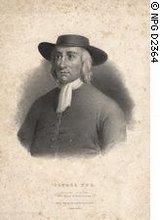I'm certainly no historian, and I am well aware of the dangers of trying to draw conclusions from a few weeks of research on any topic, but something has struck me about early Quakerism and continuity. Many of you probably understand this, but it is simply amazing to me that the Society of Friends still exists. Not because of any recent problems in our denomination (though I've had plenty to say about that), but because of the odds of any religious sect of the mid 17th century struggling through the treacherous political and religious environment of the English Civil War and restoration.
The more I learn about the peculiarities of early Friends, the more it seems that those earliest pioneers were not so unique. Many of the peculiarities that we cite today as uniquely Quakerly, such as women ministers, refusal to tithe, simplicity or plainness in speech and dress, and the prioritizing of social justice issues, were common to various sects throughout 17th century England. In fact, the critique of ceremony, rites, and outwardly lavish worship services, and a professional clerical class were founded in the work of Wycliffe in the 14th Century. Some of the seemingly peculiar Quaker tenets were simply common to a variety of radical, and not so radical English religious and political movements.
Yet, with the exception of more mainstream expressions of Protestantism like Presbyterianism, which was well established in Scotland and on the Continent, and Puritanism, which had a great military leader and had its roots in the Tyndale/Lollard movement inspired by Wycliffes's work, only the Religious Society of Friends and Baptists made it through the toughest times of this radical era.
Persecution, infighting, (and in the case of the Levellers and outright extermination) and apocalyptic burnout were the demise of movements like the Seekers, the Family of Love, and the Fifth Monarchists. But Quakers and Baptists made it through, and I think there might be two reasons, though academically trained Friends' Historians might disagree.
For one, the Baptists and Quakers organized and developed structure. As much as I have railed against the work of modern Yearly Meetings in the past, I remain convinced that the support and discipline of the organized ecclesiastical structure of early Friends pushed them through to the point of taking advantage of their extraordinary growth during more apocalyptic inclined times. Friends had staying power because, at some point, they invested in a future and stability instead of maintaining apocalyptic theology as their source of fuel.
Secondly, Friends insisted on worshipping publicly, even when it was illegal, and dangerous, and there was the threat of violence. We have all heard the stories of the meeting that was kept alive by the children of imprisoned Friends during the worst times of persecution. Friends worshipped publicly, because they sought to prove that they were not among those who sought to overthrow the existing order, per say, but to be numbered among the righteous, who could do nothing else than to practice their conscience driven theology publicly as a witness to the desire of God. Friends insistence on worshipping in public despite persecution was a source of much support, not only from sympathisers, but from opponents as well.
What does this mean for contemporary Friends? I suppose that we might take a look at our public witness, what we say to the world as Friends, and declare ourselves committed not only to the idea of peace, but to publicly providing examples of what our vision of peace in a broken world looks like. I think we might also look to our Yearly Meetings to be more active in the maintaining the spiritual health Monthly Meeting, and commit to forging new commitments to statements of unity or commonality that we might use to make our witness more visible.
In the end, it all has to be Spirit driven, and I pray that we all receive a healthy dose of the Spirit.
Subscribe to:
Post Comments (Atom)



1 comment:
The only thing I would add to your general discussion is an insight that was shared at a New Foundation get-together.
George Fox did not set out to create a "religion" (and neither did Jesus). In a sense, Fox and the rest of the broader movement sought to do away with religion altogether. In that sense, the survival of Quaker and Baptist structures required a turn away from the original impulse.
I think Friends and Baptists both shared in this impulse, although they disagreed strenuously about where the true leading was coming from once the structures of church hierarchy had been discarded. And both Friends and Baptists agreed in trying to create the minimum amount of structure necessary to carry the momentum, and as the world turned, to face the wrath of the better-established religions.
The trade-off comes into play when we look to our current structures (the YMs) "to be more active in ... maintaining the spiritual health [of our] Monthly Meetings" -- and in maintaining our own spiritual health as well.
Post a Comment